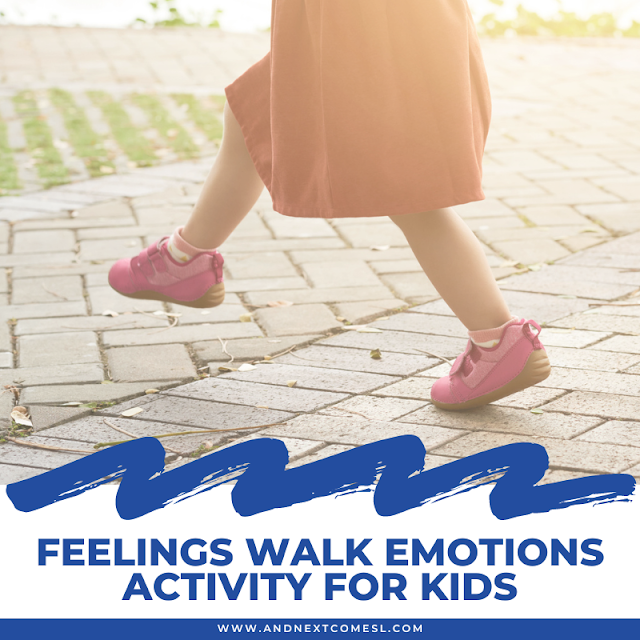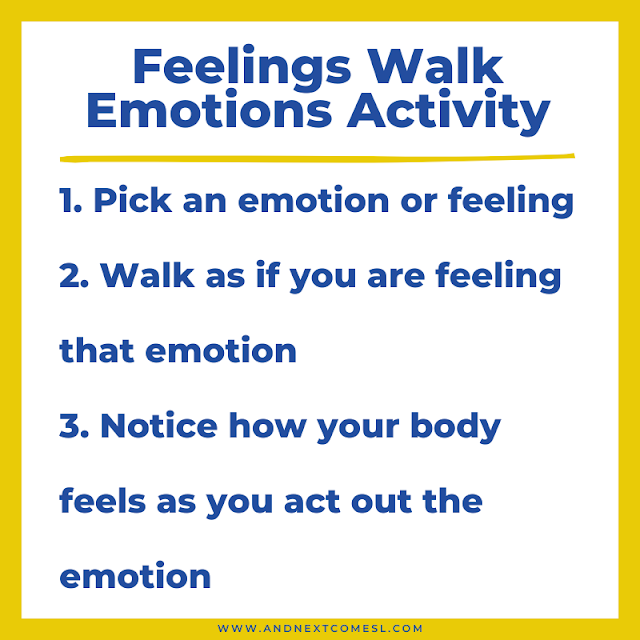Not only do kids need to be able to identify and name their emotions, but they also need to learn how to recognize those emotions in their own bodies.
Then eventually they have to learn how to manage and cope with those emotions too.
As you're probably already aware, there are a lot of skills to develop and plenty of practice to be had when it comes to emotions. So, it's not surprising that it takes years to develop strong emotional awareness and coping skills.
However, there are lots of simple activities that you can do to start building emotional intelligence with your children, regardless of their age, skill level, or abilities.
For instance, this feelings walk emotions activity focuses on teaching kids how to recognize the signs of different emotions and feelings in their bodies. It can be done wherever and whenever and requires nothing more than using your body and a bit of mindfulness practice.
How to Do a Feelings Walk with Kids
This mindfulness and emotions activity focuses on teaching kids how different emotions present themselves in our bodies. It encourages kids to focus specifically on how their body changes when we are feeling a wide variety of emotions and requires paying attention to both internal (interoception) and external signals.
Here's how this emotions activity works:
Step 1: Pick an emotion or feeling
The great thing about this activity is that you can try a wide variety of different emotions. You could try frustrated, excited, sad, angry, worried, happy, nervous...anything really! So start this activity off by picking one particular emotion to focus on.
Step 2: Walk as if you are feeling that emotion
Now imagine that you are feeling the chosen emotion from step one. Start walking as if you are feeling that way. For example, if you're happy or excited, you might have a bounce in your step. However, if you're angry, you might be stomping around.
Step 3: Notice how your body feels
This step is all about being present and noticing how your body feels as you act out the emotion. Depending on the age and skills of your child, you might need to point out some of these movements and signs. Using declarative language will be really helpful here (e.g., I noticed that you were walking slowly with your head down).
Here are some questions to consider during this step:
- Do you drag your feet?
- Do you have a slight bounce in your step?
- Are you moving fast or slow?
- Are you slouched over or do you hold your head up high?
- What are your hands and/or arms doing?
- What does your facial expression look like?
- Are you making any noises as you walk? (e.g., sighing, grumbling, etc.)
Then repeat the process over with different emotions each time. That way you can compare and contrast the different ways a body moves when expressing certain emotions.
How to Adapt this Emotions Activity
While this activity might sound simple to do, it can actually be quite challenging for some kids and adults. However, there are lots of ways you can adapt this activity to make it more successful.
One idea is to have you, an adult, do the movements so that your child can watch you do the feelings walks. I recommend exaggerating the movements and actions to really draw attention to how the body changes for the given emotion. Make it obvious for your child to spot how the body acts. Narrating what you are doing can also be helpful here.
Another idea is to do these feelings walks in front of a large mirror so that your child can observe the way the body moves or looks. They can watch themselves in the mirror, which makes it easier to spot how the movements change for different feelings.
You can also encourage your child to make notes about how the body moves, looks, and feels for each emotion you walk to, kind of like an emotions journal or something. Basically, you want your child to write down the main features of how the body changes. For example, if you are doing a feelings walk for the emotion frustrated, your child might jot down notes about clenched fists, angry eyebrows, stomping feet, etc.
If your child is a gestalt language processor, then this emotions activity can be a great way to incorporate some natural language models around emotions. For instance, you might say something like, "I'm so happy!" or "I feel frustrated!" or "I'm stomping" as you do your feelings walk.
Finally, skip the walk entirely and focus purely on facial expressions instead. To do this, you will need a mirror. Then have your child sit in front of the mirror and act out various emotions. Encourage them to notice what their face is doing when acting out different emotions.
Make the Feelings Walk Easier to Understand with These Social Stories!
Want to better prepare your child for this feelings activity? Then teach them about their different emotions first using these social stories.
- Emotions Social Story - A great introduction to how we all have a wide variety of emotions.
- Listening to my Body Social Story (Editable) - Talks about different signals your body uses to communicate different things, from hunger and sleepiness to emotions and pain.
- When I'm Sad Social Story - Explains what sadness is and what that might look like in your body.
- Anger Social Story - Describes what anger can look like.
Once you read through a few of these stories a few times, this feelings walk emotions activity should be much easier for your child to participate in. What do you think? Will you be giving this activity a try?





